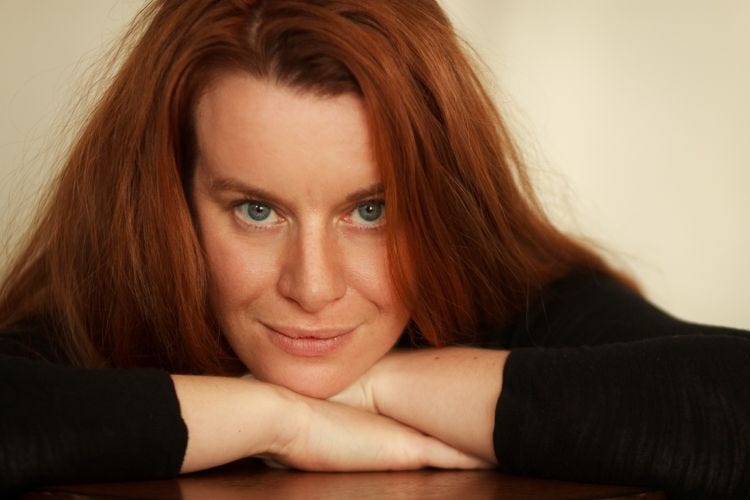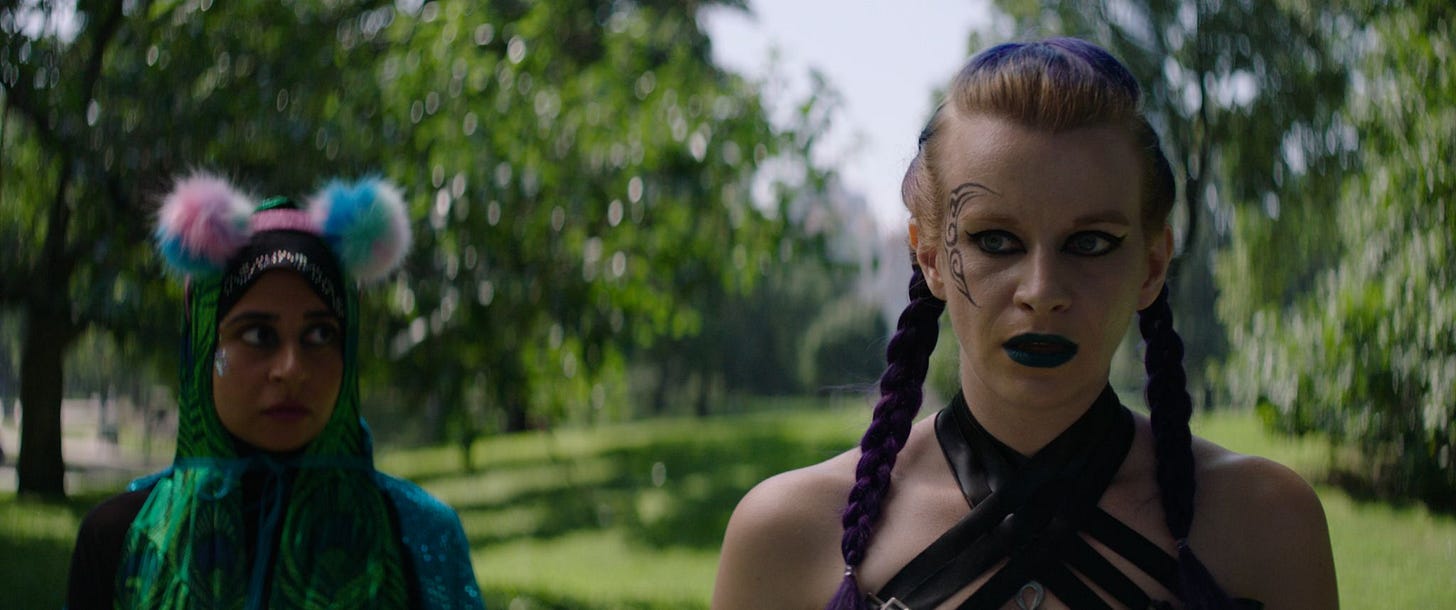Indie filmmakers have been given an outdated paradigm: make your film, get into the best festival you can, and then, trust your luck.
That’s not realistic anymore.
With Ramona at Midlife, for instance, we premiered at Bentonville, an incredible festival… during the strike. We went to market during a historic correction (“stay alive ‘til ‘25”), and now, of course, we have the fires and a massively shifting global order. The center is not holding, and it hasn’t for some time.
In The Distribution Playbook, Christie Marchese of Kinema says: “Distribution isn't a thing you get, it's a thing you do.”
Which brings us to Naomi Macdougall Jones and The Joyful Vampire Tour. To promote her film Bite Me, Naomi jumped into an RV and did screenings in cities all over the country. It was a raucous, in-person, community-building celebration of indie film.
Naomi is a force to be reckoned with: filmmaker, actor, and author. I spoke with her recently, and I am so excited to share that conversation with you.
BB: I want to talk about distribution, and specifically, why you approached distributing Bite Me in the ways you did. Can you talk about how you did it—and also why?
Naomi: We made our first feature for $80K. We didn’t get into a big shiny festival, but we managed to get a distributor to pick it up for a ten-city theatrical release. We felt like Cinderella; all of our dreams were coming true. And while the distributor was wonderful, we received five thousand dollars total ever in the lifetime of that film. And then they went out of business. And in doing so, they sold their library to a different company, and then that company stopped sending reports, and then a different company took over. So now, that film is on Amazon, but we have no way of collecting revenue. So that was a big lesson.
And we were repeatedly told that it was hard because my first film was a drama about two women, neither of whom were “name actors.”
With my second film, Bite Me, I was determined to do it differently. I made a vampire rom-com, and we got name actors. We knew exactly who our audience was, and so we cast people who were famous within that market—for example, Naomi Grossman from American Horror Story. If you know who she is, she’s your goddess.
We started having initial conversations with distributors, and they’d say things like “We don’t know how to market this film.” And I’d say, “It’s a vampire romantic comedy!” The stupidity was shocking. And of course, even when “they” are distributing it, you’re still running marketing. So I thought, “why are they taking this big cut when we’re doing all the work?”
So we decided to self-distribute. We realized we’d make more money that way, but also, we could be more strategic. We saw how, with our first film, we played twelve festivals or so, and then we had a distribution deal, but then so many people have already seen your movie, and you’ve used up their enthusiasm.
So with Bite Me, we decided to get into the best festival we could and have a premiere but also plan a tour. And by the time we premiered, tickets for our tour would already be on sale, so we could use the momentum we’d gathered.
So basically that was our bet—that we could make more money self-distributing than through a distributor.
And did you?
Yes. We made more money from the first week of ticket sales alone on the tour than we did through our first film.
And did that revenue pay for the tour?
It did pay for the tour. Our fatal flaw was that it was the year TVOD collapsed. We were banking on the tour driving TVOD sales. But what we didn’t know, and couldn’t know, was that the audience had hit their limit with subscription streaming platforms and wouldn’t pay even $2.99 for a film that wasn’t on a platform they were already paying for. TVOD sales fell radically that year.
And how are you thinking about distribution now? Would you do it differently today?
The Joyful Vampire Tour was in the summer of 2019, before Covid. At that time, we were banking on the idea that people were lonely and desperate for in-person, community gatherings. The whole tour was designed around giving people that experience. And of course the irony is that everything I’m saying became exponentially more true after Covid.
So I do think the underlying idea of our tour is right. Designing in-person events that are very low cost and that can be replicated in communities all over the place, and there might be multiple points of revenue at each event. You can sell merch! The goal is to somehow take the core thing that the film is trying to do and create an event amplifying that.
So for us, with Bite Me, it was a film to make people joyful—which is why we called it The Joyful Vampire Tour of America—and to help people feel more seen by each other… through difference, basically.
Our tour and the Joyful Vampire Ball were designed so that weirdos could let their freak flags fly and find and see each other. Because that was the film. I think you can find that same principle no matter what your film is trying to do. The event might change, but I don’t think the core idea changes.
We just did this with Ramona’s Reunion. Ramona at Midlife threw a party with New Georges, a theater cohort supporting gender equity, in honor of a program they used to run called Performathon! The themes of our movie and the Performathon Reunion were perfectly in sync, and midlife creatives, alumni of Performathon, came and felt supported and seen.
Exactly. Now most people either can’t or don’t want to move into an RV for three months to go on tour with their films—it was the most fun I’ve ever had in my life, and also it nearly killed me. So there are more sustainable versions of doing the same thing. In a way, it would be better if the events could span a year or so because it would allow time for word-of-mouth to grow. I’ve thought a lot about “regional cluster tours.” Like maybe, you go to Atlanta for two weeks and create a base there but day-trip to nearby places, like a small regional tour, and then take two months off. It’s more sustainable for everyone, but I also think it’s easier to market.
What are you excited about now? What inspires you?
I’m really excited about this book I’m writing! I think the film industry is in the total collapse portion of its regularly scheduled “boom and bust cycle”—the moment right before something new emerges.
The good news is that people still need stories, and something will happen next. The cycle will start again. We don’t know in what timeline, but it will. Because that’s what happens. So I keep saying to my students: “We’re basically in the bunker period, in terms of the industry as a machine. What do you want to use that time for?”
I think it’s a great time to make twenty-thousand-dollar films. Make the weirdest shit you can. Grab your friends and make the most exciting things that you aren’t allowed to make inside the system when it’s working.
If you have a film, you’re lucky because you don’t need the machine to distribute it. Audiences are there. You can innovate around distribution.
But it’s definitely not the time to invest in trying to get into the machine, because the machine that exists now is collapsing and will not be the machine that is there tomorrow.
Naomi McDougall Jones’s second book, American Selkie, a memoir about a woman finding her way back to her wildness and her ancestors, is forthcoming from Penguin Random House in early 2026. For more information about Naomi and her work, click here and also here. Naomi’s first book, The Wrong Kind of Woman, should be required reading for us all.
Ramona at Midlife is now available to stream on Prime! Watch the film and shoot me a note to let me know what you think. Even better, post a review on Letterboxd or Rotten Tomatoes! And if you have any questions, I’m here to answer them.
Happy Valentines Day!
Love,
Brooke







This is a great perspective. The industry is definitely shifting, and it’s interesting to see how people are adapting.
Really enjoyed this interview. I almost did the tour idea 15 years ago but got such a hard time from the funders that I gave up…also like the description of being in a sort of ‘in between’ period. Astute.